Igneous Rocks: Formation, Characteristics and Classification Report
VerifiedAdded on 2023/06/04
|10
|1181
|444
Report
AI Summary
This report provides a comprehensive overview of igneous rocks, beginning with their formation through the cooling and solidification of magma, and their classification into plutonic and volcanic rocks. It delves into the characteristics of igneous rocks, including texture, color, and composition, explaining how these properties are influenced by the cooling process, magma chemistry, and the environment of deposition. The report highlights the role of Bowen's reaction series in describing the textures and minerals associated with igneous rock formation, and classifies rocks based on color (mafic vs. felsic) and silica content. Additionally, the report discusses various textures of igneous rocks, such as phaneritic, aphanitic, porphyritic, glassy, vesicular, and fragmental (pyroclastic). The classification of igneous rocks is based on texture, color, and composition.
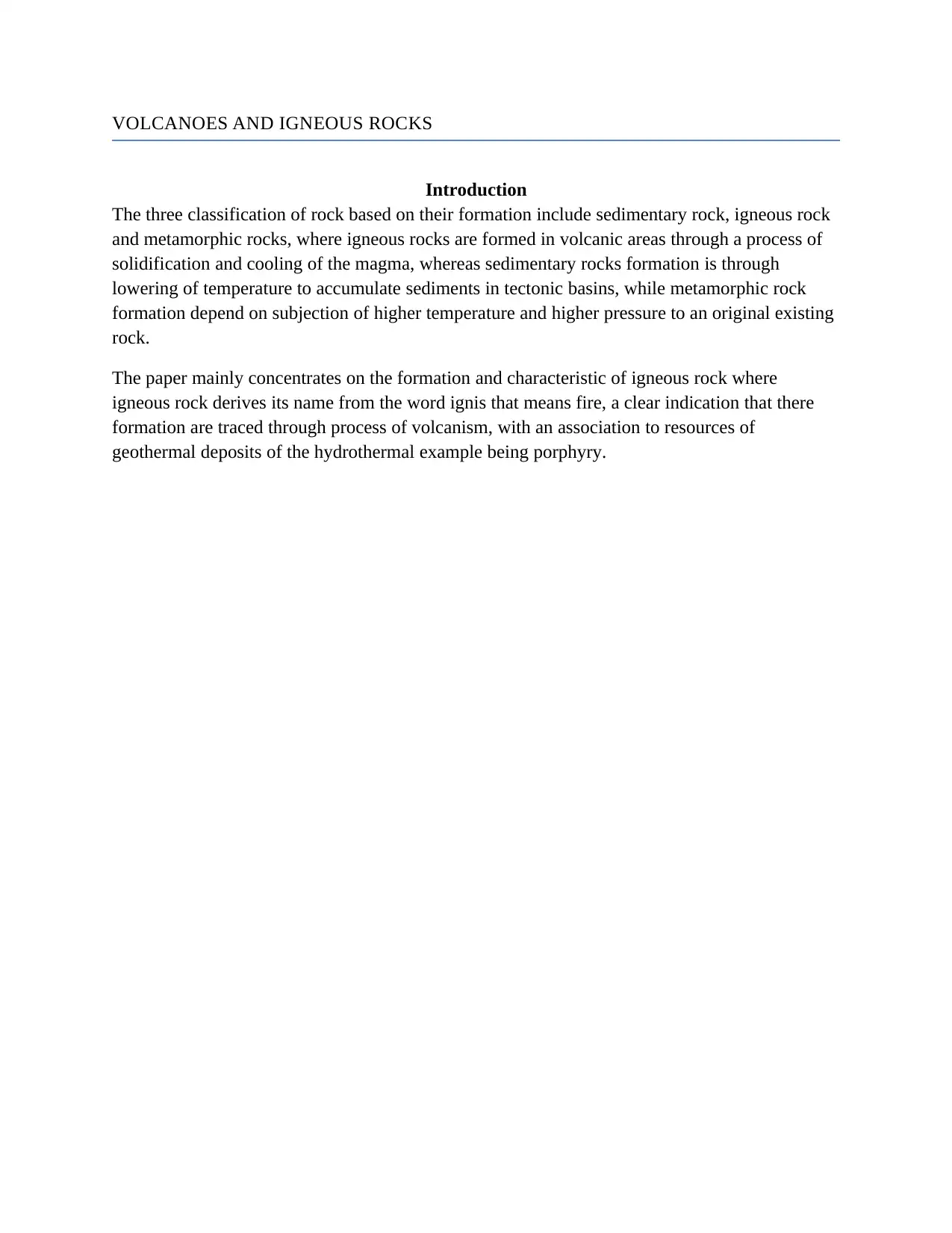
VOLCANOES AND IGNEOUS ROCKS
Introduction
The three classification of rock based on their formation include sedimentary rock, igneous rock
and metamorphic rocks, where igneous rocks are formed in volcanic areas through a process of
solidification and cooling of the magma, whereas sedimentary rocks formation is through
lowering of temperature to accumulate sediments in tectonic basins, while metamorphic rock
formation depend on subjection of higher temperature and higher pressure to an original existing
rock.
The paper mainly concentrates on the formation and characteristic of igneous rock where
igneous rock derives its name from the word ignis that means fire, a clear indication that there
formation are traced through process of volcanism, with an association to resources of
geothermal deposits of the hydrothermal example being porphyry.
Introduction
The three classification of rock based on their formation include sedimentary rock, igneous rock
and metamorphic rocks, where igneous rocks are formed in volcanic areas through a process of
solidification and cooling of the magma, whereas sedimentary rocks formation is through
lowering of temperature to accumulate sediments in tectonic basins, while metamorphic rock
formation depend on subjection of higher temperature and higher pressure to an original existing
rock.
The paper mainly concentrates on the formation and characteristic of igneous rock where
igneous rock derives its name from the word ignis that means fire, a clear indication that there
formation are traced through process of volcanism, with an association to resources of
geothermal deposits of the hydrothermal example being porphyry.
Paraphrase This Document
Need a fresh take? Get an instant paraphrase of this document with our AI Paraphraser
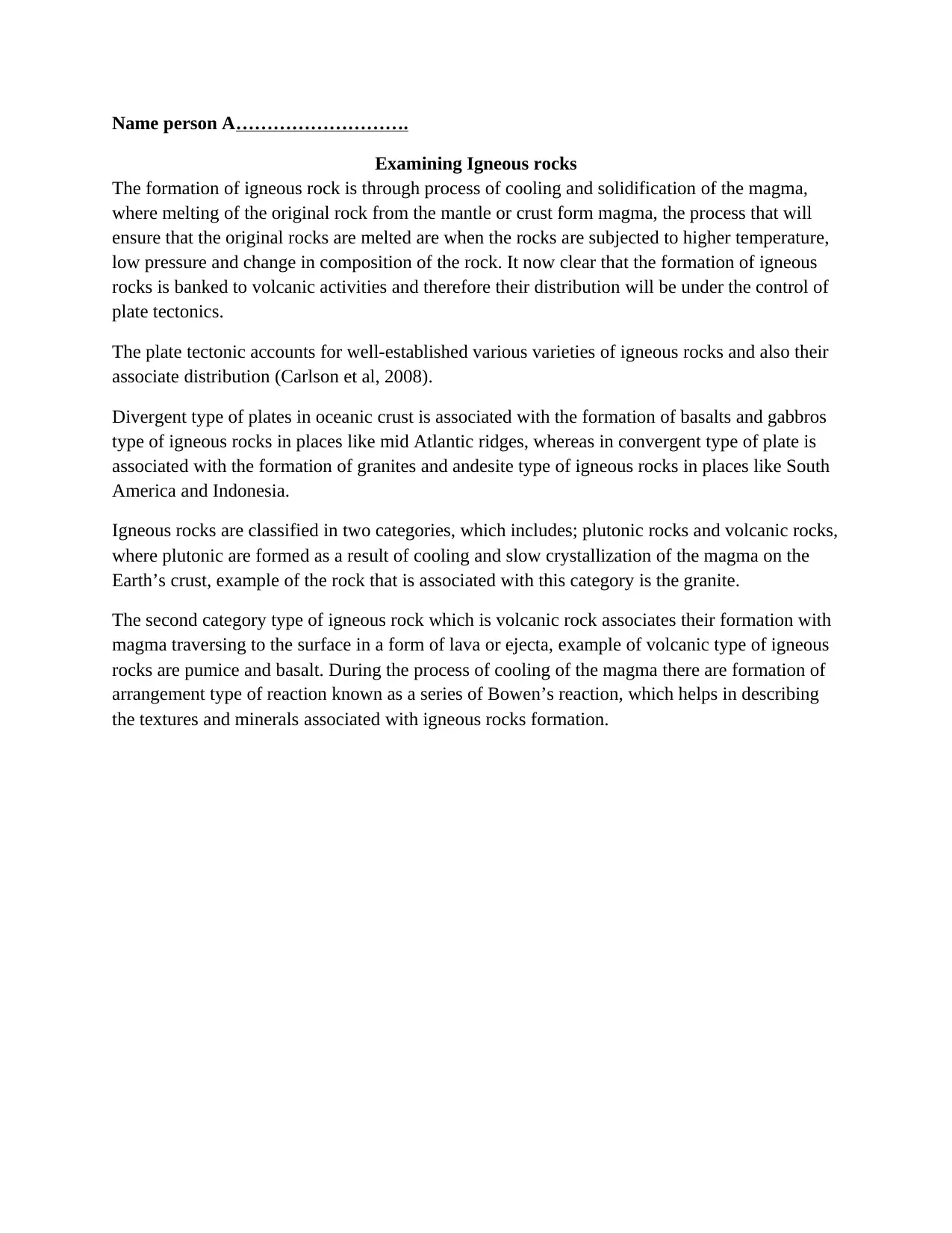
Name person A……………………….
Examining Igneous rocks
The formation of igneous rock is through process of cooling and solidification of the magma,
where melting of the original rock from the mantle or crust form magma, the process that will
ensure that the original rocks are melted are when the rocks are subjected to higher temperature,
low pressure and change in composition of the rock. It now clear that the formation of igneous
rocks is banked to volcanic activities and therefore their distribution will be under the control of
plate tectonics.
The plate tectonic accounts for well-established various varieties of igneous rocks and also their
associate distribution (Carlson et al, 2008).
Divergent type of plates in oceanic crust is associated with the formation of basalts and gabbros
type of igneous rocks in places like mid Atlantic ridges, whereas in convergent type of plate is
associated with the formation of granites and andesite type of igneous rocks in places like South
America and Indonesia.
Igneous rocks are classified in two categories, which includes; plutonic rocks and volcanic rocks,
where plutonic are formed as a result of cooling and slow crystallization of the magma on the
Earth’s crust, example of the rock that is associated with this category is the granite.
The second category type of igneous rock which is volcanic rock associates their formation with
magma traversing to the surface in a form of lava or ejecta, example of volcanic type of igneous
rocks are pumice and basalt. During the process of cooling of the magma there are formation of
arrangement type of reaction known as a series of Bowen’s reaction, which helps in describing
the textures and minerals associated with igneous rocks formation.
Examining Igneous rocks
The formation of igneous rock is through process of cooling and solidification of the magma,
where melting of the original rock from the mantle or crust form magma, the process that will
ensure that the original rocks are melted are when the rocks are subjected to higher temperature,
low pressure and change in composition of the rock. It now clear that the formation of igneous
rocks is banked to volcanic activities and therefore their distribution will be under the control of
plate tectonics.
The plate tectonic accounts for well-established various varieties of igneous rocks and also their
associate distribution (Carlson et al, 2008).
Divergent type of plates in oceanic crust is associated with the formation of basalts and gabbros
type of igneous rocks in places like mid Atlantic ridges, whereas in convergent type of plate is
associated with the formation of granites and andesite type of igneous rocks in places like South
America and Indonesia.
Igneous rocks are classified in two categories, which includes; plutonic rocks and volcanic rocks,
where plutonic are formed as a result of cooling and slow crystallization of the magma on the
Earth’s crust, example of the rock that is associated with this category is the granite.
The second category type of igneous rock which is volcanic rock associates their formation with
magma traversing to the surface in a form of lava or ejecta, example of volcanic type of igneous
rocks are pumice and basalt. During the process of cooling of the magma there are formation of
arrangement type of reaction known as a series of Bowen’s reaction, which helps in describing
the textures and minerals associated with igneous rocks formation.
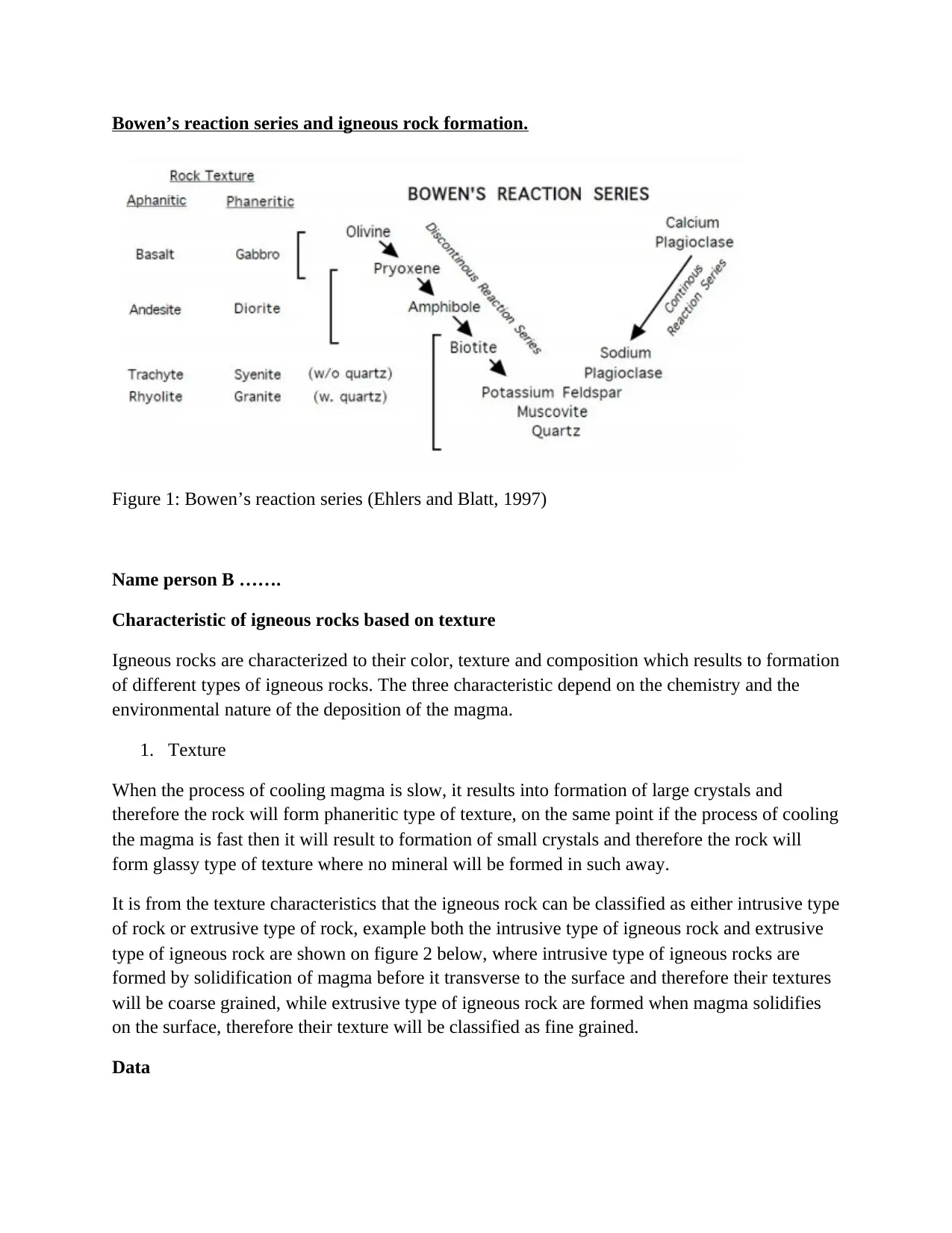
Bowen’s reaction series and igneous rock formation.
Figure 1: Bowen’s reaction series (Ehlers and Blatt, 1997)
Name person B …….
Characteristic of igneous rocks based on texture
Igneous rocks are characterized to their color, texture and composition which results to formation
of different types of igneous rocks. The three characteristic depend on the chemistry and the
environmental nature of the deposition of the magma.
1. Texture
When the process of cooling magma is slow, it results into formation of large crystals and
therefore the rock will form phaneritic type of texture, on the same point if the process of cooling
the magma is fast then it will result to formation of small crystals and therefore the rock will
form glassy type of texture where no mineral will be formed in such away.
It is from the texture characteristics that the igneous rock can be classified as either intrusive type
of rock or extrusive type of rock, example both the intrusive type of igneous rock and extrusive
type of igneous rock are shown on figure 2 below, where intrusive type of igneous rocks are
formed by solidification of magma before it transverse to the surface and therefore their textures
will be coarse grained, while extrusive type of igneous rock are formed when magma solidifies
on the surface, therefore their texture will be classified as fine grained.
Data
Figure 1: Bowen’s reaction series (Ehlers and Blatt, 1997)
Name person B …….
Characteristic of igneous rocks based on texture
Igneous rocks are characterized to their color, texture and composition which results to formation
of different types of igneous rocks. The three characteristic depend on the chemistry and the
environmental nature of the deposition of the magma.
1. Texture
When the process of cooling magma is slow, it results into formation of large crystals and
therefore the rock will form phaneritic type of texture, on the same point if the process of cooling
the magma is fast then it will result to formation of small crystals and therefore the rock will
form glassy type of texture where no mineral will be formed in such away.
It is from the texture characteristics that the igneous rock can be classified as either intrusive type
of rock or extrusive type of rock, example both the intrusive type of igneous rock and extrusive
type of igneous rock are shown on figure 2 below, where intrusive type of igneous rocks are
formed by solidification of magma before it transverse to the surface and therefore their textures
will be coarse grained, while extrusive type of igneous rock are formed when magma solidifies
on the surface, therefore their texture will be classified as fine grained.
Data
⊘ This is a preview!⊘
Do you want full access?
Subscribe today to unlock all pages.

Trusted by 1+ million students worldwide
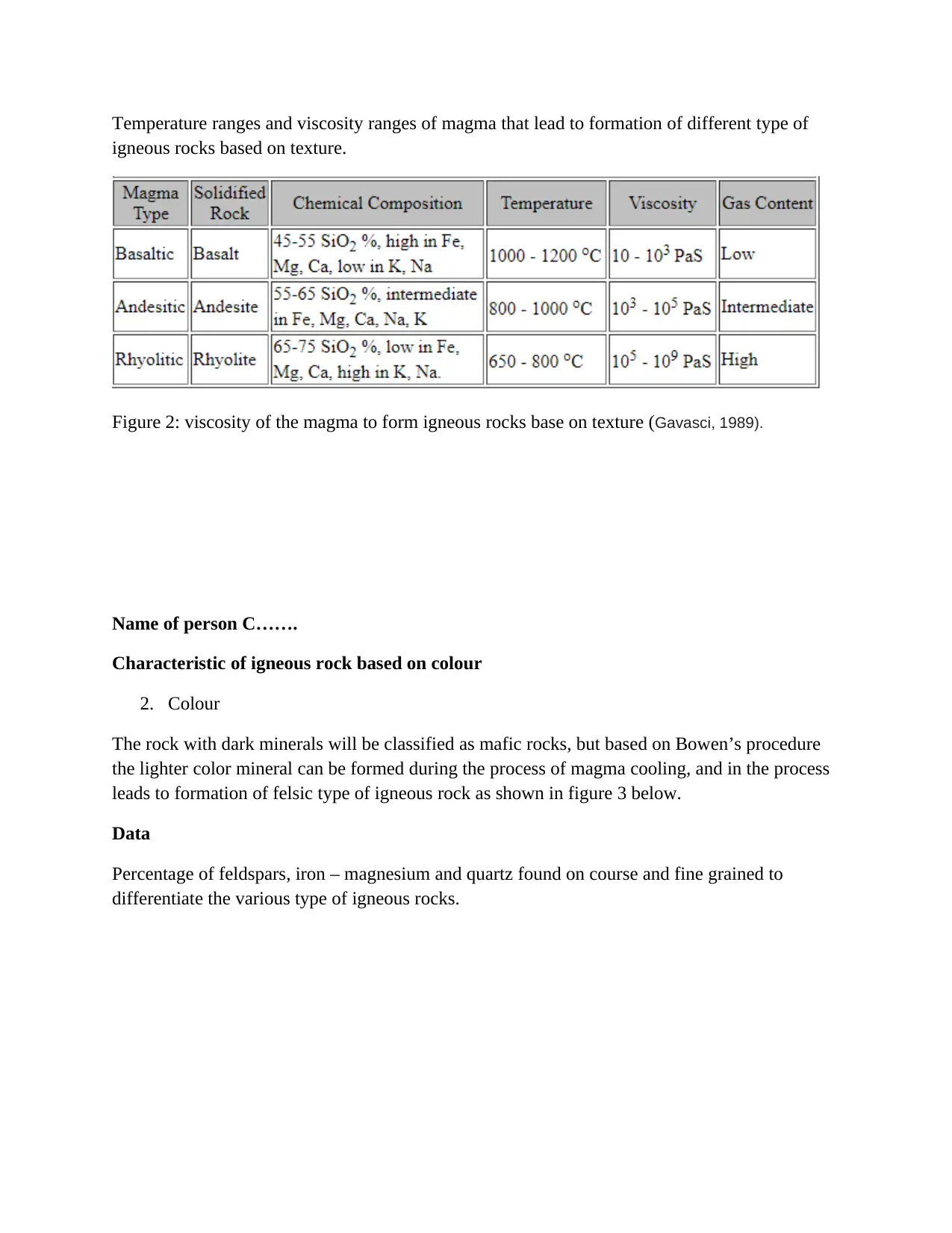
Temperature ranges and viscosity ranges of magma that lead to formation of different type of
igneous rocks based on texture.
Figure 2: viscosity of the magma to form igneous rocks base on texture (Gavasci, 1989).
Name of person C…….
Characteristic of igneous rock based on colour
2. Colour
The rock with dark minerals will be classified as mafic rocks, but based on Bowen’s procedure
the lighter color mineral can be formed during the process of magma cooling, and in the process
leads to formation of felsic type of igneous rock as shown in figure 3 below.
Data
Percentage of feldspars, iron – magnesium and quartz found on course and fine grained to
differentiate the various type of igneous rocks.
igneous rocks based on texture.
Figure 2: viscosity of the magma to form igneous rocks base on texture (Gavasci, 1989).
Name of person C…….
Characteristic of igneous rock based on colour
2. Colour
The rock with dark minerals will be classified as mafic rocks, but based on Bowen’s procedure
the lighter color mineral can be formed during the process of magma cooling, and in the process
leads to formation of felsic type of igneous rock as shown in figure 3 below.
Data
Percentage of feldspars, iron – magnesium and quartz found on course and fine grained to
differentiate the various type of igneous rocks.
Paraphrase This Document
Need a fresh take? Get an instant paraphrase of this document with our AI Paraphraser
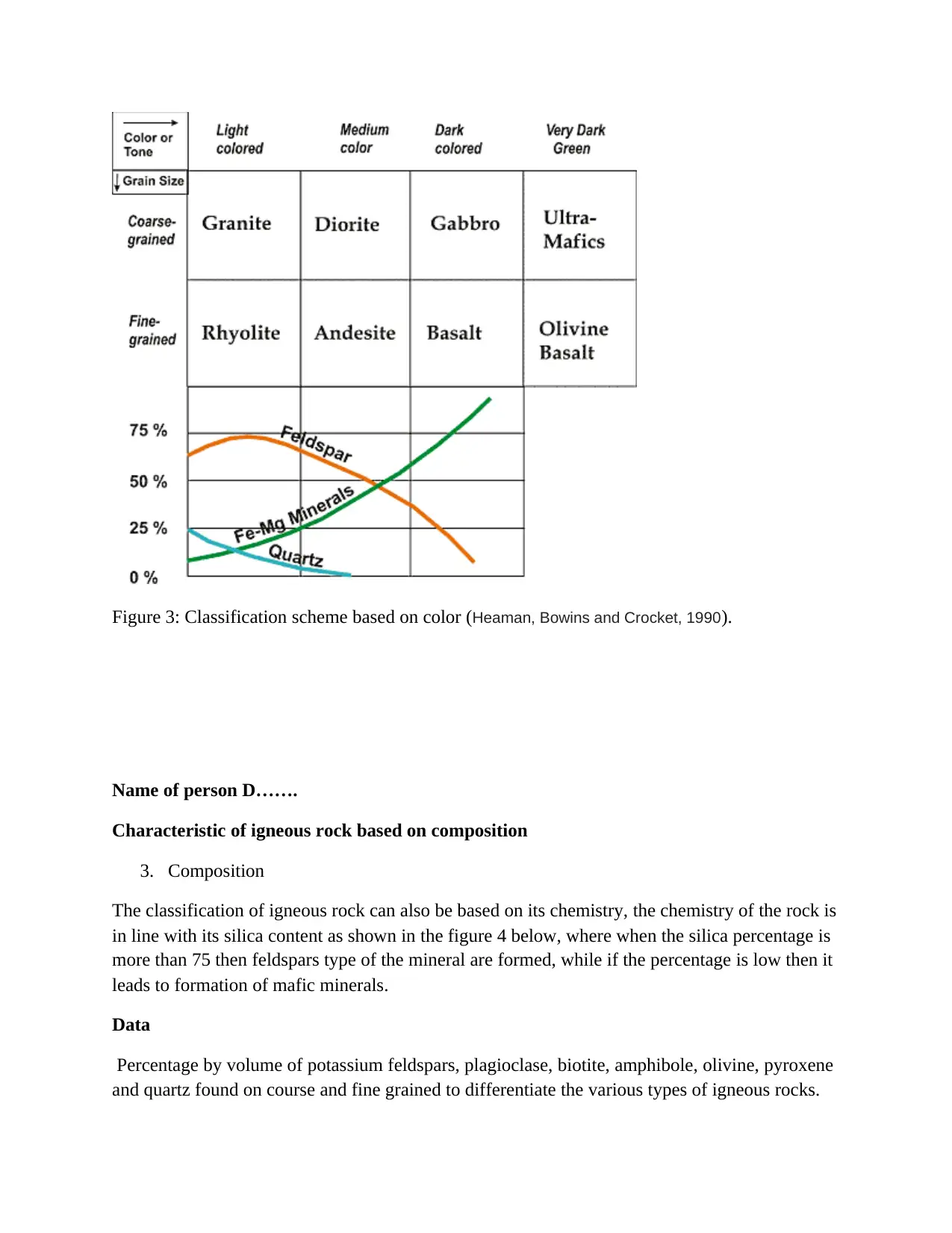
Figure 3: Classification scheme based on color (Heaman, Bowins and Crocket, 1990).
Name of person D…….
Characteristic of igneous rock based on composition
3. Composition
The classification of igneous rock can also be based on its chemistry, the chemistry of the rock is
in line with its silica content as shown in the figure 4 below, where when the silica percentage is
more than 75 then feldspars type of the mineral are formed, while if the percentage is low then it
leads to formation of mafic minerals.
Data
Percentage by volume of potassium feldspars, plagioclase, biotite, amphibole, olivine, pyroxene
and quartz found on course and fine grained to differentiate the various types of igneous rocks.
Name of person D…….
Characteristic of igneous rock based on composition
3. Composition
The classification of igneous rock can also be based on its chemistry, the chemistry of the rock is
in line with its silica content as shown in the figure 4 below, where when the silica percentage is
more than 75 then feldspars type of the mineral are formed, while if the percentage is low then it
leads to formation of mafic minerals.
Data
Percentage by volume of potassium feldspars, plagioclase, biotite, amphibole, olivine, pyroxene
and quartz found on course and fine grained to differentiate the various types of igneous rocks.
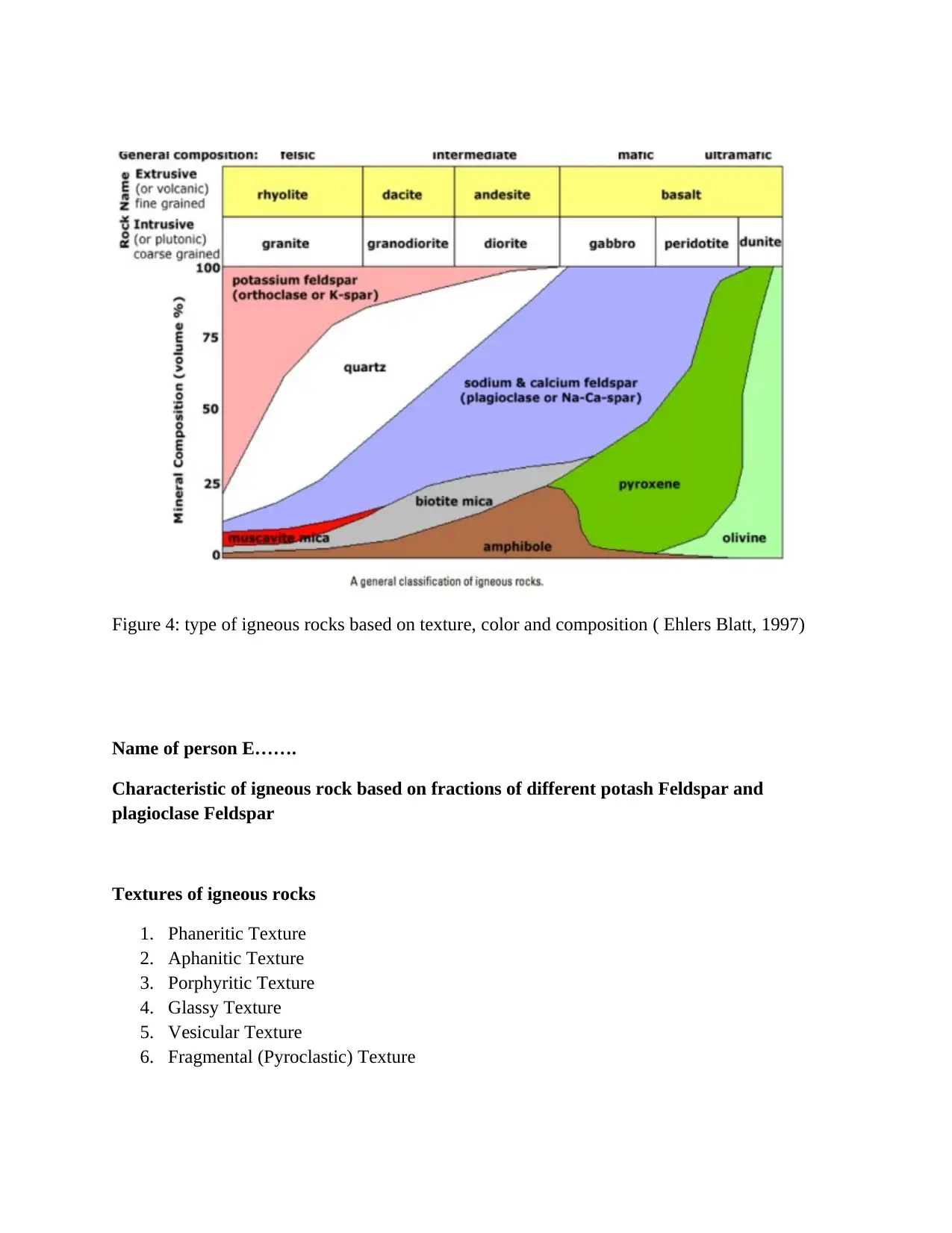
Figure 4: type of igneous rocks based on texture, color and composition ( Ehlers Blatt, 1997)
Name of person E…….
Characteristic of igneous rock based on fractions of different potash Feldspar and
plagioclase Feldspar
Textures of igneous rocks
1. Phaneritic Texture
2. Aphanitic Texture
3. Porphyritic Texture
4. Glassy Texture
5. Vesicular Texture
6. Fragmental (Pyroclastic) Texture
Name of person E…….
Characteristic of igneous rock based on fractions of different potash Feldspar and
plagioclase Feldspar
Textures of igneous rocks
1. Phaneritic Texture
2. Aphanitic Texture
3. Porphyritic Texture
4. Glassy Texture
5. Vesicular Texture
6. Fragmental (Pyroclastic) Texture
⊘ This is a preview!⊘
Do you want full access?
Subscribe today to unlock all pages.

Trusted by 1+ million students worldwide
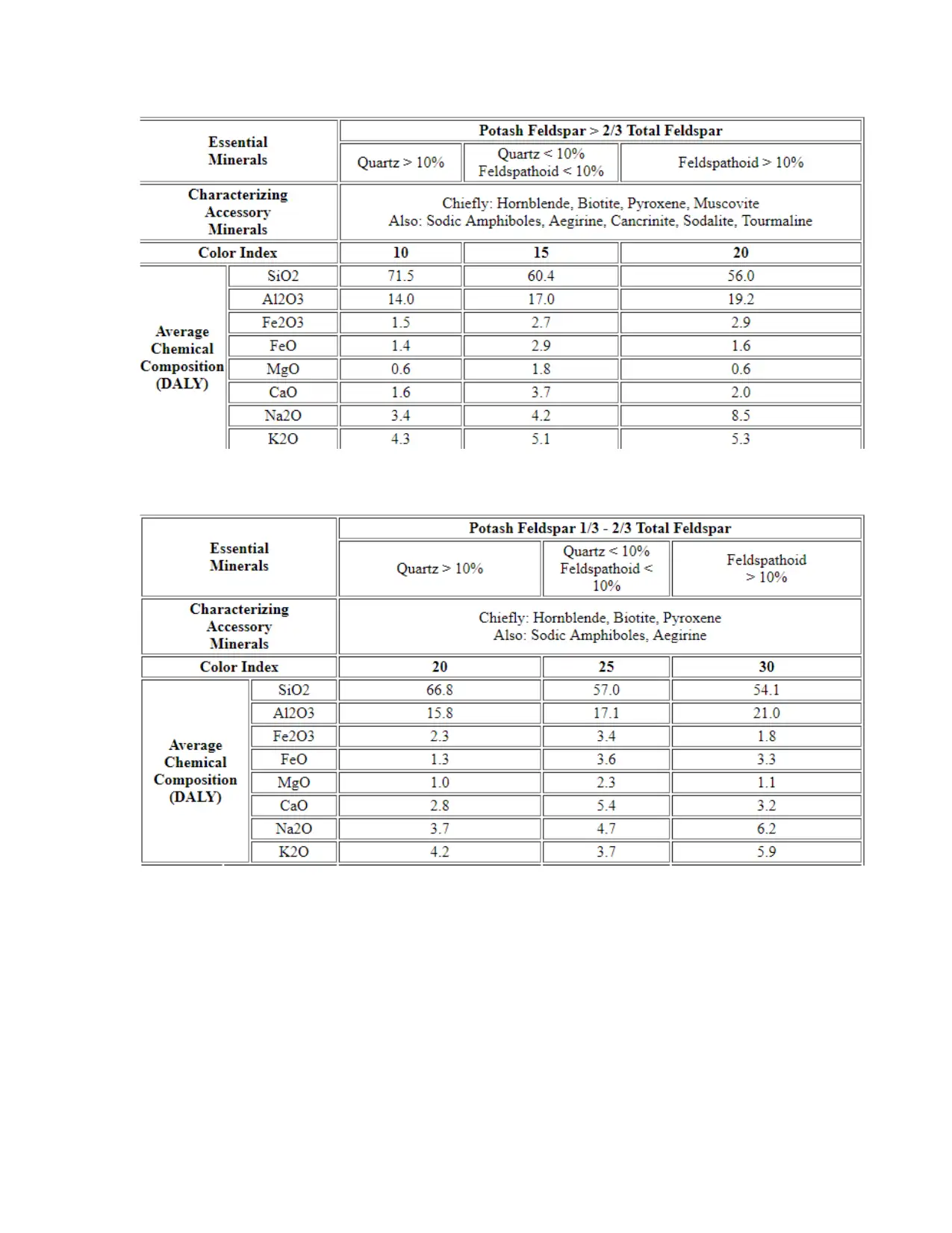
Paraphrase This Document
Need a fresh take? Get an instant paraphrase of this document with our AI Paraphraser
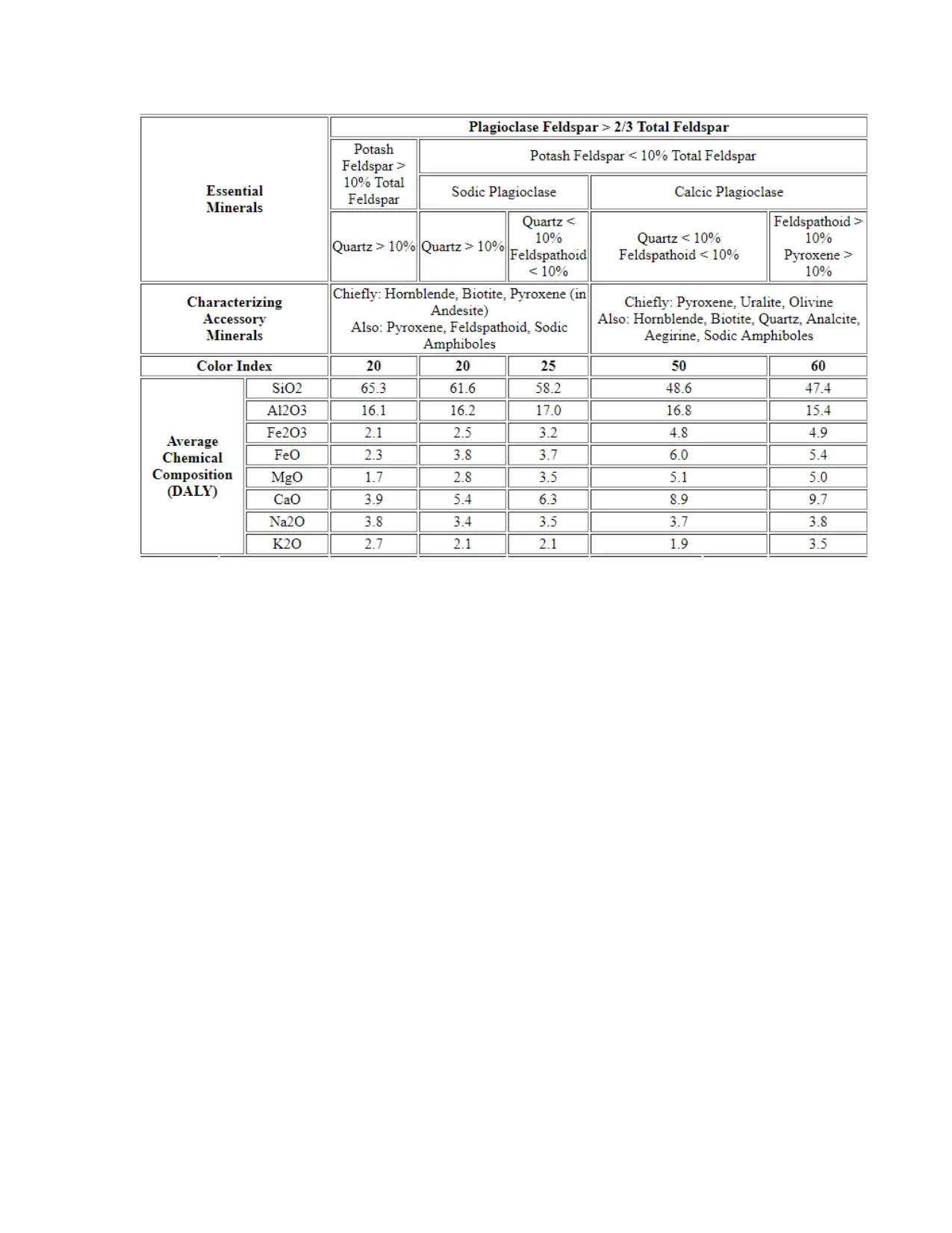

Conclusion
In collusion, the formation of the igneous rock based on its conducive characteristics will be
stated and determined, and their classification will too be determined based on the stated
different and variable conditions.
In collusion, the formation of the igneous rock based on its conducive characteristics will be
stated and determined, and their classification will too be determined based on the stated
different and variable conditions.
⊘ This is a preview!⊘
Do you want full access?
Subscribe today to unlock all pages.

Trusted by 1+ million students worldwide
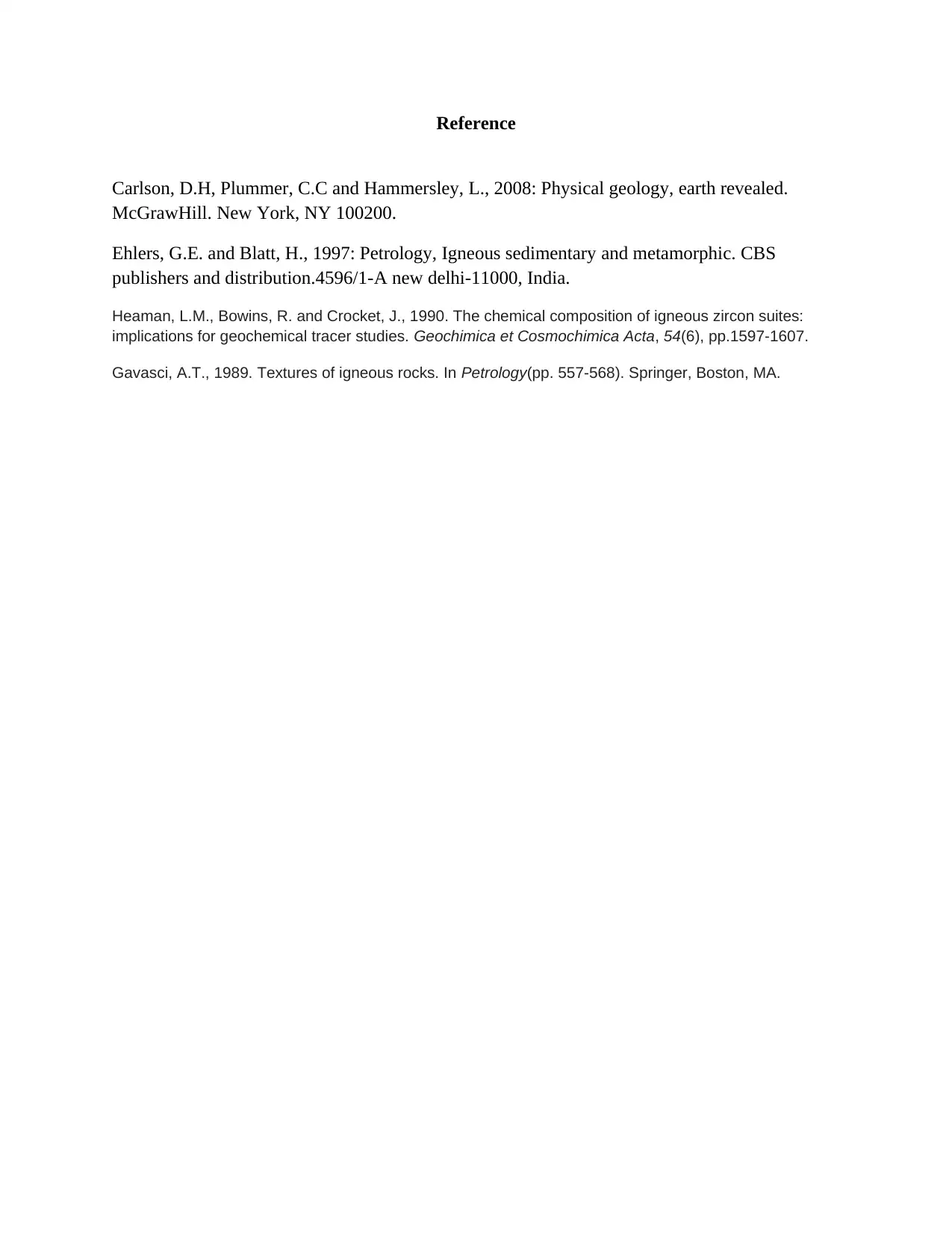
Reference
Carlson, D.H, Plummer, C.C and Hammersley, L., 2008: Physical geology, earth revealed.
McGrawHill. New York, NY 100200.
Ehlers, G.E. and Blatt, H., 1997: Petrology, Igneous sedimentary and metamorphic. CBS
publishers and distribution.4596/1-A new delhi-11000, India.
Heaman, L.M., Bowins, R. and Crocket, J., 1990. The chemical composition of igneous zircon suites:
implications for geochemical tracer studies. Geochimica et Cosmochimica Acta, 54(6), pp.1597-1607.
Gavasci, A.T., 1989. Textures of igneous rocks. In Petrology(pp. 557-568). Springer, Boston, MA.
Carlson, D.H, Plummer, C.C and Hammersley, L., 2008: Physical geology, earth revealed.
McGrawHill. New York, NY 100200.
Ehlers, G.E. and Blatt, H., 1997: Petrology, Igneous sedimentary and metamorphic. CBS
publishers and distribution.4596/1-A new delhi-11000, India.
Heaman, L.M., Bowins, R. and Crocket, J., 1990. The chemical composition of igneous zircon suites:
implications for geochemical tracer studies. Geochimica et Cosmochimica Acta, 54(6), pp.1597-1607.
Gavasci, A.T., 1989. Textures of igneous rocks. In Petrology(pp. 557-568). Springer, Boston, MA.
1 out of 10
Related Documents
Your All-in-One AI-Powered Toolkit for Academic Success.
+13062052269
info@desklib.com
Available 24*7 on WhatsApp / Email
![[object Object]](/_next/static/media/star-bottom.7253800d.svg)
Unlock your academic potential
Copyright © 2020–2025 A2Z Services. All Rights Reserved. Developed and managed by ZUCOL.





